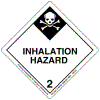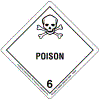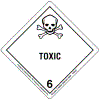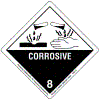Hydrogen Fluoride/Hydrofluoric Acid: Systemic Agent
CAS #:
7664-39-3
RTECS #: MW7875000
UN #: 1052 (hydrogen fluoride, anhydrous) (Guide 125) 1790 (hydrofluoric acid) (Guide 157)
Common Names:
- Fluoric acid
- HF
- Fluorhydric acid
Agent Characteristics
Hydrogen fluoride is a colorless fuming liquid below 67°F (19.4°C), or a colorless gas. When hydrogen fluoride is combined with water it is known as hydrofluoric acid, a colorless liquid, which in low concentrations is visually indistinguishable from water. Hydrofluoric acid that is more than 40% hydrogen fluoride fumes in air.
Hydrogen fluoride mixes readily with water forming hydrofluoric acid. For all practical purposes, they are considered the same chemical. Hydrogen fluoride/hydrofluoric acid is used extensively in the extraction, processing, and refining of metals, rock, brick, and oil. It is an intermediate for many chemical reactions and syntheses. It is used to remove and inhibit rust, and to etch, polish, and frost glass. It is used in the manufacture of silicon semiconductor chips. Hydrogen fluoride/hydrofluoric acid is used in commercial automotive cleaners, rust removers and inhibitors for ceramics and fabrics, and water spot removers. It is released into the environment from manufacturing and welding processes, volcanoes, and sea salt aerosol. It has a strong irritating odor; however, odor should not be depended on to provide sufficient warning of exposure. It is considered a weak acid but is still extremely harmful due to its ability to penetrate tissue.
- Indoor Air: Hydrogen fluoride/hydrofluoric acid can be released into indoor air as a liquid spray (aerosol), or as a gas.
- Water: Hydrogen fluoride/hydrofluoric acid can be used to contaminate water.
- Food: Hydrogen fluoride/hydrofluoric acid can be used to contaminate food.
- Outdoor Air: Hydrogen fluoride/hydrofluoric acid can be released into outdoor air as a liquid spray (aerosol), or as a gas.
- Agricultural: If hydrogen fluoride/hydrofluoric acid is released into the air as a liquid spray (aerosol), it has the potential to contaminate agricultural products. If hydrofluoric acid (HF) is released as a gas, it is highly unlikely to contaminate agricultural products.
Hydrogen fluoride/hydrofluoric acid can be absorbed systemically into the body by ingestion, inhalation, or skin or eye contact. Eye exposure to hydrogen fluoride/hydrofluoric acid is highly unlikely to result in systemic toxicity. Inhalation is an important route of exposure.
Personal Protective Equipment
First Responders should use a NIOSH-certified Chemical, Biological, Radiological, Nuclear (CBRN) Self Contained Breathing Apparatus (SCBA) with a Level A protective suit when entering an area with an unknown contaminant or when entering an area where the concentration of the contaminant is unknown. Level A protection should be used until monitoring results confirm the contaminant and the concentration of the contaminant.
NOTE: Safe use of protective clothing and equipment requires specific skills developed through training and experience.
Select when the greatest level of skin, respiratory, and eye protection is required. This is the maximum protection for workers in danger of exposure to unknown chemical hazards or levels above the IDLH or greater than the AEGL-2.
- A NIOSH-certified CBRN full-face-piece SCBA operated in a pressure-demand mode or a pressure-demand supplied air hose respirator with an auxiliary escape bottle.
- A Totally-Encapsulating Chemical Protective (TECP) suit that provides protection against CBRN agents.
- Chemical-resistant gloves (outer).
- Chemical-resistant gloves (inner).
- Chemical-resistant boots with a steel toe and shank.
- Coveralls, long underwear, and a hard hat worn under the TECP suit are optional items.
Select when the highest level of respiratory protection is necessary but a lesser level of skin protection is required. This is the minimum protection for workers in danger of exposure to unknown chemical hazards or levels above the IDLH or greater than AEGL-2. It differs from Level A in that it incorporates a non-encapsulating, splash-protective, chemical-resistant splash suit that provides Level A protection against liquids but is not airtight.
- A NIOSH-certified CBRN full-face-piece SCBA operated in a pressure-demand mode or a pressure-demand supplied air hose respirator with an auxiliary escape bottle.
- A hooded chemical-resistant suit that provides protection against CBRN agents.
- Chemical-resistant gloves (outer).
- Chemical-resistant gloves (inner).
- Chemical-resistant boots with a steel toe and shank.
- Coveralls, long underwear, a hard hat worn under the chemical-resistant suit, and chemical-resistant disposable boot-covers worn over the chemical-resistant suit are optional items.
Select when the contaminant and concentration of the contaminant are known and the respiratory protection criteria factors for using Air Purifying Respirators (APR) or Powered Air Purifying Respirators (PAPR) are met. This level is appropriate when decontaminating patient/victims.
- A NIOSH-certified CBRN tight-fitting APR with a canister-type gas mask or CBRN PAPR for air levels greater than AEGL-2.
- A NIOSH-certified CBRN PAPR with a loose-fitting face-piece, hood, or helmet and a filter or a combination organic vapor, acid gas, and particulate cartridge/filter combination or a continuous flow respirator for air levels greater than AEGL-1.
- A hooded chemical-resistant suit that provides protection against CBRN agents.
- Chemical-resistant gloves (outer).
- Chemical-resistant gloves (inner).
- Chemical-resistant boots with a steel toe and shank.
- Escape mask, face shield, coveralls, long underwear, a hard hat worn under the chemical-resistant suit, and chemical-resistant disposable boot-covers worn over the chemical-resistant suit are optional items.
Select when the contaminant and concentration of the contaminant are known and the concentration is below the appropriate occupational exposure limit or less than AEGL-1 for the stated duration times.
- Limited to coveralls or other work clothes, boots, and gloves.
Emergency Response
- Over time hydrogen fluoride/hydrofluoric acid corrodes metals, releasing flammable hydrogen.
- Hydrogen fluoride/hydrofluoric acid reacts with water or steam creating toxic and corrosive fumes.
- Hydrogen fluoride/hydrofluoric acid attacks glass, ceramics, concrete, some forms of plastic, rubber, and coatings.
- Hydrogen fluoride/hydrofluoric acid is very reactive with most bases, acids, and oxidants and should not be stored with them.
- Upper and lower explosion limits are not applicable to hydrogen fluoride/hydrofluoric acid because it is a nonflammable gas.
- Hydrogen fluoride/hydrofluoric acid forms explosive gases when mixed with methanesulfonic acid, or polymerizing cyanogens.
- Containers may explode when heated or if contaminated with water.
- Ruptured cylinders may rocket.
- UN 1052, anhydrous hydrogen (HF), may burn, but it does not ignite readily.
- Fire will produce irritating, corrosive, and/or toxic gases.
- For small fires involving UN 1052, use dry chemical or carbon dioxide.
- For large fires involving UN 1052, use water spray, fog, or regular foam. Move containers from the fire area if it is possible to do so without risk to personnel. Do not get water inside containers. Damaged cylinders should be handled only by specialists.
- For fire involving tanks of UN 1052, fight the fire from maximum distance or use unmanned hose holders or monitor nozzles. Cool containers with flooding quantities of water until well after the fire is out. Do not direct water at the source of the leak or at safety devices; icing may occur. Withdraw immediately in case of rising sound from venting safety devices or discoloration of tanks. Always stay away from tanks engulfed in fire.
- Note: Most foams will react with UN 1790 and release corrosive/toxic gases.
- For small fires involving UN 1790, hydrofluoric acid (HF), use carbon dioxide, dry chemical, dry sand, or alcohol-resistant foam.
- For large fires involving UN 1790, use water spray, fog, or alcohol-resistant foam. Move containers from the fire area if it is possible to do so without risk to personnel. Use water spray or fog; do not use straight streams. Dike fire control water for later disposal; do not scatter the material.
- For fire involving tanks or car/trailer loads of UN 1790, fight the fire from maximum distance or use unmanned hose holders or monitor nozzles. Do not get water inside containers. Cool containers with flooding quantities of water until well after the fire is out. Withdraw immediately in case of rising sound from venting safety devices or discoloration of tanks. Always stay away from tanks engulfed in fire.
- Run-off from fire control or dilution water may be corrosive and/or toxic, and it may cause pollution.
- If the situation allows, control and properly dispose of run-off (effluent).
- If a tank, rail car, or tank truck is involved in a fire, isolate it for 1 mi (1600 m) in all directions; also consider initial evacuation for 1 mi (1600 m) in all directions.
- This agent is not included in the DOT ERG 2004 Table of Initial Isolation and Protective Action Distances.
- In the DOT ERG 2004 orange-bordered section of the guidebook, there are public safety recommendations to isolate a hydrofluoric acid (Guide 125) spill or leak area immediately for at least 300 ft (100 m) in all directions.
- Hydrogen fluoride/hydrofluoric acid vapors may collect and stay in poorly-ventilated, low-lying, or confined areas (e.g., sewers, basements, and tanks).
- Hazardous concentrations may develop quickly in enclosed, poorly-ventilated, or low-lying areas. Keep out of these areas. Stay upwind.
- Health: 4
- Flammability: 0
- Reactivity: 1
- Special:
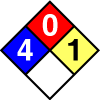
- OSHA: ID110
- NIOSH: 7902, 7903, 7906
- AIR MATRIX
Kullman GJ, Jones WG, Cornwell RJ, Parker JE [1994]. Characterization of air contaminants formed by the interaction of lava and sea-water. Environ Health Perspect 102(5):478-482.NIOSH [1994]. NMAM Method 7902 Fluorides, aerosol and gas by ISE. In: NIOSH Manual of analytical methods. 4th ed. Cincinnati, OH: U.S. Department of Health and Human Services, Public Health Service, Centers for Disease Control and Prevention, National Institute for Occupational Safety and Health, DHHS (NIOSH) Publication 94-113.NIOSH [1994]. NMAM Method 7903 Acids, inorganic. In: NIOSH Manual of analytical methods. 4th ed. Cincinnati, OH: U.S. Department of Health and Human Services, Public Health Service, Centers for Disease Control and Prevention, National Institute for Occupational Safety and Health, DHHS (NIOSH) Publication 94-113. - OTHER
No references were identified for this sampling matrix for this agent. - SOIL MATRIX
No references were identified for this sampling matrix for this agent. - SURFACES
No references were identified for this sampling matrix for this agent. - WATER
Morales JA, de Graterol LS, Velasquez H, de Nava MG, de Borrego BS [1998]. Determination by ion chromatography of selected organic and inorganic acids in rainwater at Maracaibo, Venezuela. J Chromatogr A 804(1-2):289-294.
Signs/Symptoms
For all routes of exposure, the severity and timing of adverse health effects from exposure to hydrogen fluoride/hydrofluoric acid are primarily dependent on the concentration of hydrogen fluoride/hydrofluoric acid and the duration of exposure.
Dermal:
- Immediate pain and tissue destruction are seen following exposure to a = 50% solution of hydrogen fluoride/hydrofluoric acid.
- Burns due to 20%-50% hydrogen fluoride/hydrofluoric acid solutions are apparent within 1 to 8 hours after the exposure.
- Erythema and pain can be delayed for several hours (up to 24) following exposure to a = 20% solution of hydrogen fluoride/hydrofluoric acid.
- If untreated, exposure to dilute solutions can produce delayed severe burning or throbbing pain with or without redness.
Inhalation:
- Inhalation of hydrogen fluoride/hydrofluoric acid may result in immediate irritation or may be delayed up to 12 to 36 hours.
Ocular:
- Eye exposure to more concentrated hydrogen fluoride/hydrofluoric acid vapor may result in adverse effects several hours following exposure.
- Dilute solutions have produced delayed toxicity as long as 4 days after the exposure.
Ingestion:
- Corrosiveness of hydrogen fluoride/hydrofluoric acid increases as the concentration of the solution increases.
- However, even lower concentrations of hydrogen fluoride/hydrofluoric acid can result in fatality.
- Spontaneous emesis, severe metabolic acidosis, hypotension, and death have occurred within 90 minutes of ingestion of a commercially available rust remover.
Systemic adverse health effects can occur by exposure to hydrogen fluoride/hydrofluoric acid by skin contact, inhalation, or ingestion. Effects are dependent on the concentration of hydrogen fluoride/hydrofluoric acid, the duration and size of the exposure, and the penetrability of the site of exposure. Adverse health effects include irritation of the skin, eyes, mucous membranes, and respiratory tract; accumulation of fluid in the lungs (pulmonary edema); nausea and vomiting; gastric pain; irregular heart rate (cardiac arrhythmia); tissue destruction and burns; low blood calcium (hypocalcemia); and possibly death.
- Mild: Rapid onset of irritation and reversible clouding (opacification) of the surface of the eye (cornea).
- Severe (e.g., with exposure to liquid hydrogen fluoride/hydrofluoric acid): Rapid onset of pain, redness and damage to the surface of the eye (cornea), sloughing of the cornea, swelling, and progressive damage and scarring leading to permanent clouding (opacification) of the cornea, which may occur immediately or be delayed for several days after exposure.
- Permanent visual defects are more likely with severe exposures.
- Eye exposure to vapor may cause delayed findings of eye and mucous membrane irritation; more serious eye injury is possible following exposure to concentrated vapor.
- Nausea; vomiting (emesis); abdominal pain; local burns to the mouth, throat, and esophagus, including painful localized areas of dead tissue (necrotic lesions); inflammation and bleeding of the stomach (hemorrhagic gastritis); and inflammation of the pancreas (pancreatitis).
- Even minor ingestions of hydrogen fluoride/hydrofluoric acid are likely to result in systemic exposure.
- Death may occur.
- See Inhalation Exposure.
- Mild: Irritation of the moist linings of the nose and throat (mucous membranes), possible burns, cough, narrowing of the large airways (bronchoconstriction), and difficulty breathing or shortness of breath (dyspnea).
- Severe: Immediate narrowing and swelling of the throat, upper airway obstruction, accumulation of fluid in the lungs (pulmonary edema), and partial or complete lung collapse.
- Whole-body (systemic) effects are likely, including low blood levels of calcium and magnesium (hypocalcemia and hypomagnesemia), high blood levels of potassium (hyperkalemia), low blood pressure (hypotension), abnormal or disordered heart rhythms (dysrhythmias), accumulation of acid in blood and tissues (metabolic acidosis), involuntary muscle contractions, seizures, and death.
- Concentrations < 20%: Redness (erythema), pain, and serious injury (possibly delayed for 24 hours and often reported after significant tissue injury has occurred).
- Concentrations 20-50%: Redness (erythema), pain, and serious injury (possibly delayed for 24 hours and often reported after significant tissue injury has occurred).
- Concentrations > 50%: Immediate redness (erythema) and severe, throbbing pain; rapid tissue destruction (whitish discoloration followed by blistering (vesication)); and acute whole-body (systemic) effects (including lung damage).
- Exposure of more than 1% of the body’s surface area may lead to systemic toxicity.
- See Ingestion.
Decontamination
The purpose of decontamination is to make an individual and/or their equipment safe by physically removing toxic substances quickly and effectively. Care should be taken during decontamination, because absorbed agent can be released from clothing and skin as a gas. Your Incident Commander will provide you with decontaminants specific for the agent released or the agent believed to have been released.
The following are recommendations to protect the first responders from the release area:
- Position the decontamination corridor upwind and uphill of the hot zone. The warm zone should include two decontamination corridors. One decontamination corridor is used to enter the warm zone and the other for exiting the warm zone into the cold zone. The decontamination zone for exiting should be upwind and uphill from the zone used to enter.
- Decontamination area workers should wear appropriate PPE. See the PPE section of this card for detailed information.
- A solution of detergent and water (which should have a pH value of at least 8 but should not exceed a pH value of 10.5) should be available for use in decontamination procedures. Soft brushes should be available to remove contamination from the PPE. Labeled, durable 6-mil polyethylene bags should be available for disposal of contaminated PPE.
The following methods can be used to decontaminate an individual:
- Decontamination of First Responder:
- Begin washing PPE of the first responder using soap and water solution and a soft brush. Always move in a downward motion (from head to toe). Make sure to get into all areas, especially folds in the clothing. Wash and rinse (using cold or warm water) until the contaminant is thoroughly removed.
- Remove PPE by rolling downward (from head to toe) and avoid pulling PPE off over the head. Remove the SCBA after other PPE has been removed.
- Place all PPE in labeled durable 6-mil polyethylene bags.
- Decontamination of Patient/Victim:
- Remove the patient/victim from the contaminated area and into the decontamination corridor.
- Remove all clothing (at least down to their undergarments) and place the clothing in a labeled durable 6-mil polyethylene bag.
- Thoroughly wash and rinse (using cold or warm water) the contaminated skin of the patient/victim using a soap and water solution. Be careful not to break the patient/victim’s skin during the decontamination process, and cover all open wounds.
- Cover the patient/victim to prevent shock and loss of body heat.
- Move the patient/victim to an area where emergency medical treatment can be provided.
First Aid
Initial treatment is primarily supportive. It includes monitoring of signs and symptoms of whole-body (systemic) toxicity, which can be fatal. Rapid decontamination and use of a fluoride binding agent are critical. Treatment is a continuum of care: removal from site, followed by rapid decontamination, followed by rapid treatment with a fluoride binding agent.
There is no antidote for hydrofluoric acid (HF) toxicity. Calcium- or magnesium-containing antacids (which bind fluoride ion) have been suggested for use in the treatment of ingestion exposure. Quaternary ammonium compounds or calcium-containing gels may be used topically in the treatment of skin burns. The use of iced benzalkonium chloride 0.13% soaks has been advocated as the treatment of choice for both concentrated and dilute dermal hydrofluoric acid (HF) exposure. Hemodialysis has been recommended for severe systemic toxicity.
- Immediately remove the patient/victim from the source of exposure.
- Immediately wash eyes with large amounts of tepid water for at least 15 minutes.
- If irritation persists, continue washing eyes with water or saline.
- Wash eyes with saline during transport.
- Use of anesthetic eye drops may increase the patient/victim’s comfort and the efficiency of irrigation.
- Do not use oils, salves, or ointments for injured eyes.
- Do not use the gel form of calcium gluconate in eyes.
- Seek medical attention immediately.
- Immediately remove the patient/victim from the source of exposure.
- Ensure that the patient/victim has an unobstructed airway.
- Do not induce vomiting (emesis).
- If the patient/victim is alert and able to swallow, immediately administer 4 to 8 ounces (120 to 240 mL) of milk or water (not to exceed 4 ounces/120 mL in a child).
- Attempt immediate administration of a fluoride binding substance: chewable calcium carbonate tablets (e.g., Tums™) or 4 to 8 ounces (120 to 240 mL) of milk of magnesia or a liquid antacid (e.g., Maalox™). Avoid large amounts of liquid, as this may induce vomiting (emesis).
- If the victim vomits, clean up and isolate vomited material using paper towels and plastic bags. Use extreme caution, as vomited material may contain hydrogen fluoride/hydrofluoric acid.
- Observe and evaluate the patient/victim for mouth and gastrointestinal (GI) tract burns.
- Seek medical attention immediately.
- Immediately remove the patient/victim from the source of exposure.
- Evaluate respiratory function and pulse.
- Ensure that the patient/victim has an unobstructed airway.
- If shortness of breath occurs or breathing is difficult (dyspnea), administer oxygen.
- Assist ventilation as required. Always use a barrier or bag-valve-mask device.
- If breathing has ceased (apnea), provide artificial respiration.
- Monitor the patient/victim for signs of whole-body (systemic) effects and administer symptomatic treatment as necessary.
- See Ingestion first aid.
- Seek medical attention immediately.
- Immediately remove the patient/victim from the source of exposure.
- See the Decontamination section for patient/victim decontamination procedures.
- Continue skin irrigation or treatment during transport.
- Do not use calcium chloride to treat skin burns.
- If practical, immersion of the burned body part into an iced, aqueous solution of a quaternary ammonium compound (e.g., 0.13% benzalkonium chloride) is recommended.
- If immersion is not practical, soaked compresses of the same iced solution should be applied to the burned area.
- If immersion in, or use of soaked compresses of, 0.13% benzalkonium chloride is not possible, topical application of 2.5% to 33% calcium gluconate or carbonate gel or slurry has been recommended. Gel or slurry must be continuously massaged into the affected area to be effective.
- Compresses should be changed or soaked with additional solution approximately every 2 to 4 minutes.
- Immersion or compresses should be used for at least 2 hours.
- Monitor the patient/victim for signs of whole-body (systemic) effects.
- If signs of whole-body (systemic) poisoning appear, see the Ingestion section for treatment recommendations.
- Seek medical attention immediately.
Long-Term Implications
For eye exposure, immediately consult an ophthalmologist. The prognosis is ultimately dependent on the timeliness and effectiveness of first aid/decontamination. For minor exposures with very dilute hydrofluoric acid (HF): mix 10 mL of 10% calcium gluconate with 100 mL of normal saline to give an approximately 1% calcium gluconate solution. With a syringe, irrigate the eye intermittently for a period of 15 to 30 minutes or until relief of pain occurs. For more serious hydrofluoric acid (HF) eye burns, mix 50 mL of 10% calcium gluconate with 500 mL of normal saline to give an approximately 1% calcium gluconate solution. After administering local anesthetic eye drops, instill the solution over a period of 1 to 2 hours. Longer use of the solution could damage the cornea. Do not use benzalkonium solutions (recommended for topical skin application) in the eye. For inhalation exposure administer a 2.5% calcium gluconate solution as a nebulized treatment with oxygen. For skin exposure, consult with a burn specialist or plastic surgeon. Injection of 5% calcium gluconate is indicated as the primary medical treatment for large burns. If benzalkonium chloride soaks or calcium gluconate gel do not provide significant relief of pain within 30 to 40 minutes, injection of calcium gluconate solution is indicated. Injection of calcium gluconate may also be indicated for burns in which treatment has been delayed. Sterile 5% aqueous calcium gluconate should be injected beneath, around, and into the burned area (0.5 ml per square centimeter). Intra-arterial injection of calcium gluconate may be necessary for treatment of burned digits and the upper extremity. Local anesthetics are not recommended in burn treatment, because the degree of pain is an indicator of treatment efficacy. For ingestion, some cases may require endoscopic examination. Do not administer emetics. Do not administer charcoal. Systemic effects may occur following exposure by all routes. Hemodialysis with fluoride free water (and normal to low potassium and slightly higher calcium concentrations) should be considered in all cases of serious burns and may need to be repeated. Hypocalcemia (low calcium level in the blood) may be corrected with 10% calcium gluconate (0.1 to 0.2 mL/kg IV up to 10 mL, repeated as necessary). Hypomagnesemia (low magnesium level in the blood) may be corrected with 50% magnesium sulfate (2 to 4 mL IV over 40 minutes). Patient/victims should be monitored for hyperkalemia (high potassium level in the blood) and treated aggressively. Observation and monitoring of the patient/victim for at least 24 hours has been recommended, as signs and symptoms, including those of pulmonary edema (fluid build-up in the lungs), may be delayed for 24 to 72 hours. Severe lung injury may require treatment with bronchodilators and inhaled and injected steroids.
After severe inhalation injury, survivors may suffer residual chronic lung disease. After skin exposure, healing of skin burns may be prolonged, and extensive scarring may result. Fingertip injuries are troublesome with persistent pain, bone loss, and nail-bed injury. After eye exposure, prolonged or permanent visual defects, blindness, or total eye destruction may occur. Ingestion may damage the esophagus and stomach progressively for weeks, and it may cause persistent narrowing of the esophagus.
Hydrogen fluoride/hydrofluoric acid has not been classified as a carcinogen. It is not known whether chronic or repeated exposure to hydrogen fluoride/hydrofluoric acid increases the risk of reproductive toxicity or developmental toxicity. Chronic or repeated exposure to hydrogen fluoride/hydrofluoric acid has been associated with fluorosis, mottling of the teeth, weight loss, malaise, anemia, leukopenia, discoloration of teeth, osteosclerosis, skeletal changes such as increased bone density of the spine and pelvis, calcification of ligaments, hyperostosis, and liver or kidney damage.
On-Site Fatalities
- Consult with the Incident Commander regarding the agent dispersed, dissemination method, level of PPE required, location, geographic complications (if any), and the approximate number of remains.
- Coordinate responsibilities and prepare to enter the scene as part of the evaluation team along with the FBI HazMat Technician, local law enforcement evidence technician, and other relevant personnel.
- Begin tracking remains using waterproof tags.
- Wear PPE until all remains are deemed free of contamination.
- Establish a preliminary (holding) morgue.
- Gather evidence, and place it in a clearly labeled impervious container. Hand any evidence over to the FBI.
- Remove and tag personal effects.
- Perform a thorough external evaluation and a preliminary identification check.
- See the Decontamination section for decontamination procedures.
- Decontaminate remains before they are removed from the incident site.
Occupational Exposure Limits
- NIOSH REL:
- TWA (10-hour): 3 ppm (2.5 mg/m3)
- Ceiling (15-minute): 6 ppm (5 mg/m3)
- OSHA PEL:
- TWA (8-hour): 3 ppm
- ACGIH TLV:
- 3 ppm
- NIOSH IDLH: 30 ppm
- DOE TEEL:
- TEEL-0: 0.818 mg/m3
- TEEL-1: 0.818 mg/m3
- TEEL-2: 19.6 mg/m3
- TEEL-3: 36 mg/m3
- AIHA ERPG:
- ERPG-1: 2 ppm
- ERPG-2: 20 ppm
- ERPG-3: 50 ppm
Acute Exposure Guidelines
| 10 min | 30 min | 60 min | 4 hr | 8 hr | |
|---|---|---|---|---|---|
| AEGL 1 (discomfort, non-disabling) – ppm |
1.0 ppm | 1.0 ppm | 1.0 ppm | 1.0 ppm | 1.0 ppm |
| AEGL 2 (irreversible or other serious, long-lasting effects or impaired ability to escape) – ppm |
95 ppm | 34 ppm | 24 ppm | 12 ppm | 12 ppm |
| AEGL 3 (life-threatening effects or death) – ppm |
170 ppm | 62 ppm | 44 ppm | 22 ppm | 22 ppm |
Decontamination (Environment and Equipment)
The following methods can be used to decontaminate the environment/spillage disposal:
- Do not touch or walk through the spilled agent if at all possible. However, if you must, personnel should wear the appropriate PPE during environmental decontamination. See the PPE section of this card for detailed information.
- Keep combustibles (e.g., wood, paper, and oil) away from the spilled agent. Use water spray to reduce vapors or divert vapor cloud drift. Avoid allowing water runoff to contact the spilled agent.
- Do not direct water at the spill or the source of the leak.
- Stop the leak if it is possible to do so without risk to personnel, and turn leaking containers so that gas rather than liquid escapes.
- Prevent entry into waterways, sewers, basements, or confined areas.
- Isolate the area until gas has dispersed.
- Ventilate the area.
Agents can seep into the crevices of equipment making it dangerous to handle. The following methods can be used to decontaminate equipment:
- Not established/determined
Agent Properties
- Chemical Formula:
HF - Aqueous solubility:
Soluble - Boiling Point:
67.1°F (19.51°C)
Solution in water: 234°F (112.2°C) - Density:
Liquid: 1.0 at 67°F (19.54°C)
Vapor: 0.7 (air = 1) - Flammability:
Nonflammable - Flashpoint:
Not established/determined
- Ionization potential:
15.98 eV
- Log Kbenzene-water:
Not established/determined - Log Kow (estimated):
0.23 - Melting Point:
-118.4°F (-83.55°C) - Molecular Mass:
20.01
- Soluble In:
Very soluble in alcohol
- Specific Gravity:
Liquid: 1.00 at 67°F (19.5°C) - Vapor Pressure:
783 mm Hg - Volatility:
Not established/determined
Hazardous Materials Warning Labels/Placards
- Shipping Name:
Hydrogen fluoride, anhydrous (1052)
Hydrofluoric acid, with not more than 60 percent strength (1790) - Identification Number:
1052 (hydrogen fluoride, anhydrous) (Guide 125)
1790 (hydrofluoric acid) (Guide 157) - Hazardous Class or Division:
8(1052) - Subsidiary Hazardous Class or Division:
6.1, Inhalation Hazard (1790) - Label:
Corrosive, Poison (Toxic) (1052)
Corrosive, Poison (Toxic), Inhalation Hazard (1790) - Placard Image:
Trade Names and Other Synonyms
- Acide fluorhydrique (French)
- Acido fluorhidrico (Spanish)
- Acido fluoridrico (Italian)
- Anhydrous hydrofluoric acid
- Antisal 2b
- Deuteriumfluoride
- Etching acid
- Fluohydric acid
- Fluorhydric acid
- Fluoric acid
- Fluorohydric acid
- Fluorowodor (Polish)
- Fluorure d’hydrogene anhydre (French)
- Fluoruro de hidrogeno anhidro (Spanish)
- Fluorwasserstoff (German)
- Fluorwaterstof (Dutch)
- HF A
- Hydrofluoride
- Rubigine
In the event of a poison emergency, call the poison center immediately at 1-800-222-1222. If the person who is poisoned cannot wake up, has a hard time breathing, or has convulsions, call 911 emergency services.
For information on who to contact in an emergency, see the CDC website at emergency.cdc.gov or call the CDC public response hotline at (888) 246-2675 (English), (888) 246-2857 (Español), or (866) 874-2646 (TTY).
The user should verify compliance of the cards with the relevant STATE or TERRITORY legislation before use. NIOSH, CDC 2003.

